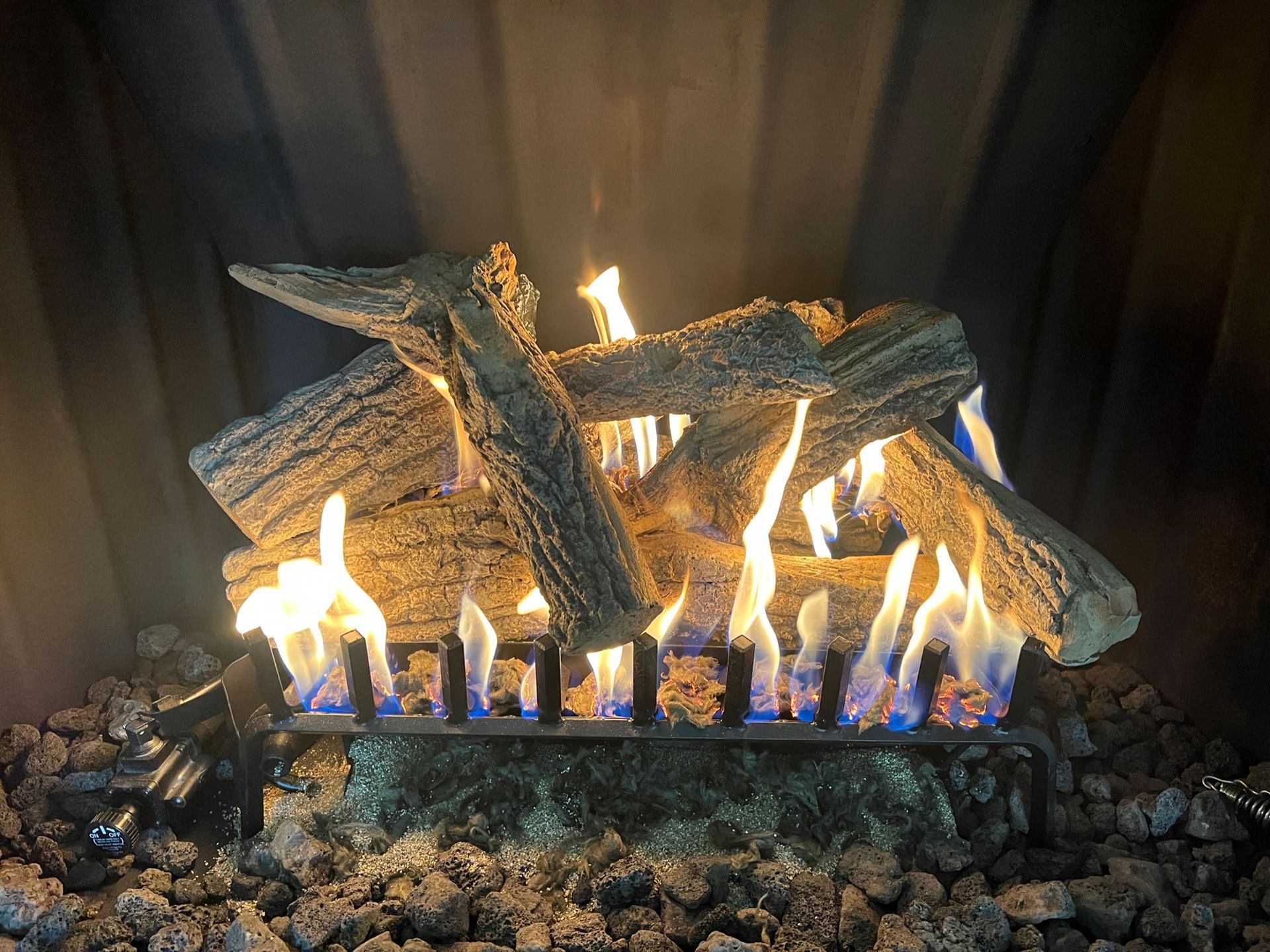Blog

By Kindled Timber
•
16 Apr, 2024
As the sun dips below the horizon and the chill of the evening sets in, there's something inherently comforting about gathering around a crackling fire. It's a timeless ritual that brings people together, fostering warmth not just in the physical sense, but in the bonds of camaraderie and conversation. While traditional wood-burning fire pits have their charm, outdoor gas fire pits offer a modern alternative that combines convenience, efficiency, and ambiance. Let's delve into the world of outdoor gas fire pits and discover how they can elevate your outdoor living space. Effortless Elegance: One of the most appealing aspects of gas fire pits is their simplicity. Unlike their wood-burning counterparts, which require constant tending and maintenance, gas fire pits offer instant ignition at the flip of a switch or push of a button. This means no more hauling heavy logs, no more cleaning up ash, and no more waiting for the flames to die down at the end of the night. With gas fire pits, you can enjoy the beauty of a roaring fire without the hassle. Versatility in Design: Another advantage of gas fire pits is their versatility in design. Whether your outdoor space is expansive or intimate, modern or rustic, there's a gas fire pit to suit every style and preference. From sleek, minimalist models that seamlessly blend into contemporary settings to ornate, artisan-crafted designs that serve as focal points in traditional landscapes, the options are virtually limitless. Some gas fire pits even come with customizable features such as adjustable flame height and interchangeable media like fire glass or lava rocks, allowing you to tailor the aesthetics to your liking. Safety and Environmental Considerations: In addition to their convenience and aesthetic appeal, gas fire pits also offer practical benefits in terms of safety and environmental friendliness. Unlike wood-burning fires, which produce smoke, sparks, and embers that can pose hazards to both people and property, gas fire pits burn cleanly and efficiently, with no harmful emissions or airborne particulates. This makes them ideal for use in areas where wood fires may be restricted due to air quality regulations or fire bans. Furthermore, gas fire pits eliminate the risk of runaway fires caused by flying sparks or improperly extinguished embers, providing peace of mind for homeowners and ensuring a safer outdoor environment for everyone. Year-Round Enjoyment: One of the greatest joys of owning a gas fire pit is the ability to extend the outdoor living season beyond the warm summer months. With the flick of a switch, you can transform your patio or backyard into a cozy oasis where you can relax, entertain, and unwind year-round. Whether you're hosting a winter bonfire with friends, toasting marshmallows on a crisp autumn evening, or simply enjoying a quiet moment under the stars on a cool spring night, a gas fire pit adds warmth and ambiance to any outdoor gathering, regardless of the season. Outdoor gas fire pits offer a convenient, stylish, and eco-friendly alternative to traditional wood-burning fire pits. With their effortless ignition, versatile design options, safety features, and year-round usability, gas fire pits are the perfect addition to any outdoor living space. Whether you're looking to create a cozy gathering spot for family and friends or enhance the ambiance of your backyard retreat, a gas fire pit provides the perfect focal point for outdoor enjoyment, allowing you to savor the simple pleasure of gathering around a glowing fire whenever the mood strikes.

By Kindled Timber
•
15 Mar, 2024
Exploring the Costs of Installing a Fireplace: Factors to Consider Adding a fireplace to your home can enhance comfort, ambiance, and value, but it's essential to understand the costs involved before embarking on this project. In this blog, we'll explore the various factors that contribute to the cost of installing a fireplace, as well as tips for budgeting and maximizing value. Type of Fireplace: The type of fireplace you choose significantly impacts the overall cost of installation. Traditional wood-burning fireplaces tend to be the most expensive due to the need for chimney construction, ventilation, and safety considerations. Gas fireplaces are typically more affordable and offer greater efficiency and convenience. Electric fireplaces are the most budget-friendly option, as they require minimal installation and no venting. Construction and Materials: The construction of the fireplace and surrounding hearth can vary in complexity and materials, affecting the overall cost of the project. Custom-built masonry fireplaces made of brick, stone, or tile tend to be more expensive than prefabricated fireplace units. Additional features such as mantels, surrounds, and hearth extensions can also add to the cost. Ventilation and Chimney Requirements: Proper ventilation is crucial for safe operation and code compliance with wood-burning and gas fireplaces. If your home does not already have a chimney or venting system, you'll need to factor in the cost of chimney construction or installation of a venting system. Direct-vent gas fireplaces offer a cost-effective alternative to traditional chimneys, as they require only a small vent pipe to the exterior. Professional Installation: Hiring a qualified contractor or fireplace installer is essential for ensuring proper installation and compliance with building codes and safety standards. Installation costs vary depending on the complexity of the project, location, and labor rates in your area. Be sure to obtain multiple quotes from reputable contractors and clarify the scope of work and any additional costs upfront. While the cost of installing a fireplace can vary widely depending on factors such as the type of fireplace, materials, installation, and permits, it's essential to approach the project with careful planning and budgeting. Consider your priorities, lifestyle, and long-term goals when selecting the right fireplace for your home, and work with experienced professionals to ensure a successful installation. With proper planning and investment, a fireplace can become a cherished centerpiece of your home for years to come.

By Kindled Timber
•
25 Feb, 2024
Electric fireplaces have surged in popularity in recent years, offering homeowners an attractive and convenient alternative to traditional wood-burning or gas fireplaces. From their ease of installation to their energy efficiency, electric fireplaces provide numerous benefits that make them an appealing choice for modern living spaces. In this blog, we'll explore the compelling reasons why you should consider investing in an electric fireplace for your home. Easy Installation and Versatility: One of the most significant advantages of electric fireplaces is their ease of installation. Unlike traditional fireplaces that require complex venting systems or chimney installations, electric fireplaces can be easily mounted on a wall or inserted into an existing fireplace opening. They are versatile and can be placed in any room of the house, providing instant ambiance and warmth without the need for extensive renovations. Energy Efficiency and Cost Savings: Electric fireplaces are highly energy-efficient, as they do not produce any emissions or require fuel consumption for operation. Unlike wood-burning or gas fireplaces that lose heat through their chimneys, electric fireplaces generate heat directly into the room, ensuring maximum efficiency and minimal heat loss. By using electricity as their power source, electric fireplaces offer cost-effective heating solutions that can help reduce energy bills and lower overall heating expenses. Safe and Eco-Friendly Operation: Electric fireplaces are a safe and eco-friendly option for heating your home. Unlike wood-burning fireplaces that emit smoke, particulates, and harmful pollutants into the air, electric fireplaces produce zero emissions and pose no health risks to you or your family. They are equipped with advanced safety features such as automatic shut-off timers, cool-to-touch glass, and overheat protection, providing peace of mind and worry-free operation. Convenient and Low Maintenance: With electric fireplaces, there is no need to worry about cleaning up ash, soot, or chimney maintenance. They require minimal upkeep and can be easily turned on and off with the push of a button or remote control. Electric fireplaces also offer customizable flame settings, allowing you to adjust the flame intensity, color, and heat output to suit your preferences and mood. Aesthetic Appeal and Design Options: Electric fireplaces come in a variety of styles, sizes, and designs to complement any home décor and personal taste. Whether you prefer a sleek and modern wall-mounted fireplace or a traditional mantel-style unit with realistic flame effects, there are countless options available to suit your aesthetic preferences. Electric fireplaces also offer the flexibility to change the flame colors, ember bed styles, and media options, allowing you to create a customized look that enhances the ambiance of your living space. In conclusion, electric fireplaces offer a host of benefits that make them an attractive choice for homeowners seeking convenience, energy efficiency, safety, and style. With their easy installation, low maintenance requirements, and versatile design options, electric fireplaces provide the warmth and ambiance of a traditional fireplace without the hassle or environmental impact. Consider incorporating an electric fireplace into your home to enjoy the comfort and beauty of a cozy fire year-round.

By Kindled Timber
•
25 Feb, 2024
Best Practices for Wood-Burning Fireplaces Wood-burning fireplaces add warmth, charm, and ambiance to any home, but they also require proper care and attention to ensure safety and efficiency. In this guide, we'll explore the best practices for maintaining and using wood-burning fireplaces to maximize enjoyment while minimizing risks. Choose Quality Firewood: Start with quality firewood that is properly seasoned and free of moisture. Seasoned hardwoods like oak, maple, or birch burn cleaner and produce less creosote buildup than softwoods. Avoid burning treated wood, painted wood, or scraps with glue or chemicals, as they can release harmful toxins. Ensure Proper Ventilation: Good airflow is essential for efficient combustion and proper venting of smoke and gases. Keep the damper fully open when lighting and tending the fire, and ensure the chimney flue is clear of obstructions. Annual chimney cleanings and inspections by a certified professional are vital to prevent creosote buildup and chimney fires. Build and Maintain a Clean Firebox: Keep the firebox clean and free of ashes, debris, and unburned wood to promote better airflow and prevent excessive heat buildup. Use a fireplace shovel and ash bucket to safely remove ashes after each use, and dispose of them in a metal container stored outside the home. Practice Safe Fire Starting: Use proper fire-starting techniques, such as crumpled newspaper or kindling, to ignite the fire gradually. Avoid using accelerants like gasoline or lighter fluid, as they can cause flare-ups and pose significant safety hazards. Consider using natural fire starters made from wood shavings or wax for convenience and reliability. Monitor and Maintain the Fire: Once the fire is burning steadily, maintain it at a moderate temperature by adding small amounts of wood as needed. Avoid overloading the firebox with too much wood, as it can lead to excessive heat output and inefficient burning. Use fireplace tools like tongs and pokers to adjust and arrange the logs for optimal airflow and heat distribution. Install Carbon Monoxide Detectors: Wood-burning fireplaces can produce carbon monoxide (CO) gas, which is odorless and potentially deadly if inhaled in high concentrations. Install carbon monoxide detectors on every level of your home, especially near sleeping areas, to provide early warning of CO buildup and ensure your family's safety. Supervise Children and Pets: Always supervise children and pets around the fireplace to prevent accidents and burns. Use a sturdy fireplace screen or gate to create a barrier between young children and the flames, and teach them about the dangers of playing with fire and hot surfaces. By following these best practices for wood-burning fireplaces, you can enjoy the warmth and comfort of a crackling fire while maintaining safety and efficiency in your home. Remember to schedule annual chimney inspections and cleanings, practice responsible fire management, and prioritize safety at all times. With proper care and attention, your wood-burning fireplace will continue to be a beloved centerpiece of your home for years to come.


